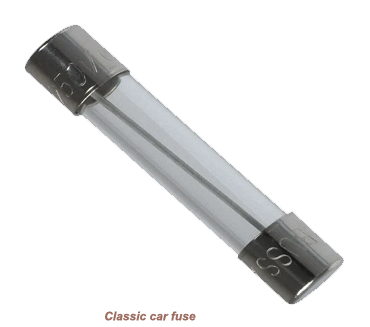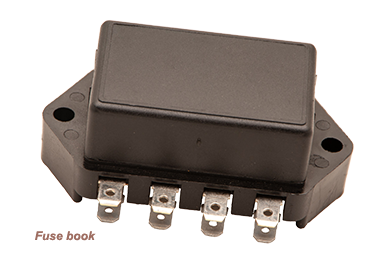
 Maintaining the fuses in a classic car is an important part of keeping the vehicle running smoothly and safely.
Maintaining the fuses in a classic car is an important part of keeping the vehicle running smoothly and safely.
Fuses play the imortant task of protecting electrical components and wiring from damage caused by electrical overloads, short circuits, and other issues.
![]()
![]() The fuse box is usually located under the dashboard or in the engine compartment. Refer to the owner's manual or consult a mechanic if you're not sure where to find it.
The fuse box is usually located under the dashboard or in the engine compartment. Refer to the owner's manual or consult a mechanic if you're not sure where to find it.

![]() Remove each fuse one by one and inspect it for signs of damage, such as a broken filament or a discolored appearance. If a fuse appears to be faulty, replace it with a new one of the same amperage rating.
Remove each fuse one by one and inspect it for signs of damage, such as a broken filament or a discolored appearance. If a fuse appears to be faulty, replace it with a new one of the same amperage rating.
![]() Over time, the contacts inside the fuse box can become dirty or corroded. Use a soft-bristled brush or a clean cloth to gently clean the contacts and ensure a good electrical connection.
Over time, the contacts inside the fuse box can become dirty or corroded. Use a soft-bristled brush or a clean cloth to gently clean the contacts and ensure a good electrical connection.
![]() Be careful not to overload the electrical system by adding too many accessories or running high-wattage components without upgrading the wiring or electrical system.
Be careful not to overload the electrical system by adding too many accessories or running high-wattage components without upgrading the wiring or electrical system.
![]() Regularly check the fuses in your classic car to ensure they are not blown. A blown fuse will cause a specific electrical component to stop working, so it is important to identify and replace them as soon as possible.
Regularly check the fuses in your classic car to ensure they are not blown. A blown fuse will cause a specific electrical component to stop working, so it is important to identify and replace them as soon as possible.
 A sure indicator that a fuse has blown is when the wire element within the fuse will have melted or burned because of sudden increase in electrical current. It is not necessary to remove the fuse in order to determine whether or not it has blown All that is needed is a simple test , using a test light or a multimeter.
A sure indicator that a fuse has blown is when the wire element within the fuse will have melted or burned because of sudden increase in electrical current. It is not necessary to remove the fuse in order to determine whether or not it has blown All that is needed is a simple test , using a test light or a multimeter.
These instruments come at a reasonable price and are simple to operate.
![]() Check the fuses for any signs of wear or damage, such as a melted or discolored appearance- a sure fire indication that the fuse has been overworked and will likely need to be replaced.
Check the fuses for any signs of wear or damage, such as a melted or discolored appearance- a sure fire indication that the fuse has been overworked and will likely need to be replaced.
 When something goes wrong with your electrical system, such a short circuit or another problem, the fuse will explode. It indicates that it has successfully prevented any additional harm to your vehicle's wiring or equipment while performing its duty to do so.
When something goes wrong with your electrical system, such a short circuit or another problem, the fuse will explode. It indicates that it has successfully prevented any additional harm to your vehicle's wiring or equipment while performing its duty to do so.
A blown fuse may also indicate that there is an issue with the electrical system or the wiring that needs to be fixed as soon as possible.
It is possible for fuses to become defective without ever actually blowing. They may become corroded as a result of exposure to moisture, although this is usually an extremely rare occurrence.
![]() Make sure that the fuses you use in your classic car are the correct type and rating for the electrical component they protect.
Make sure that the fuses you use in your classic car are the correct type and rating for the electrical component they protect.
The current carrying capacity of a fuse is denoted by its colour. For instance, a conventional blue fuse has a 15-amp rating, while a yellow fuse has a 20-amp rating, and a green fuse has a 30-amp rating. It is important to remember, before buying new fuses, that the fuse panel cover may still contain spare fuses and even a fuse puller.
Using the wrong type of fuse can cause damage to the component or even start a fire.
![]()
 It's a good idea to keep a supply of spare fuses on hand, in case one blows while you are driving. Make sure you have the right type and rating of fuses, so you're prepared in case of an emergency.
It's a good idea to keep a supply of spare fuses on hand, in case one blows while you are driving. Make sure you have the right type and rating of fuses, so you're prepared in case of an emergency.

![]() The fuse box itself should be checked to see if it is corroded or damaged in any way, if so it's best to have it repaired or replaced. In many cases the owner’s manual, if it is still around, will advise how to locate the vehicle s fuse box, as well as a diagram explaining which fuses control what. Always consult the car's manual if there is one available for specific information on the type and rating of fuses required for your classic car. If not any reputable auto electrician or spares centre will have the information
The fuse box itself should be checked to see if it is corroded or damaged in any way, if so it's best to have it repaired or replaced. In many cases the owner’s manual, if it is still around, will advise how to locate the vehicle s fuse box, as well as a diagram explaining which fuses control what. Always consult the car's manual if there is one available for specific information on the type and rating of fuses required for your classic car. If not any reputable auto electrician or spares centre will have the information
It is important to keep an eye on the fuses, as it's a relatively simple but crucial component that can prevent damage to your car's electrical systems. Regular inspections and maintenance can help prevent issues, and ensure that your classic car's fuses are in top working condition.
br4


